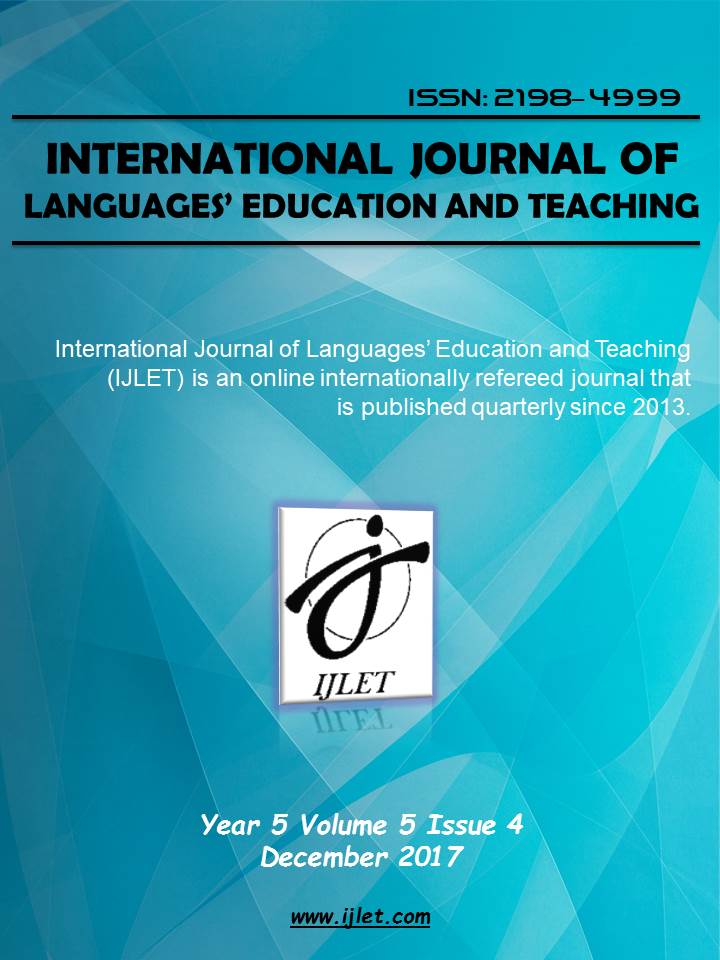Author :
Abstract
Keywords
Abstract
Contrary to learning styles seem the same as what abilities refer, they are related to them in the sense that they decipher how individuals desire to use their capabilities. There have been diverse learning styles theories intent to explain the individual differences on account of the acceleration and the amount of absorbed knowledge. Learning styles have been defined under the notions of cognitive, affective and physiological attributes that serve as nearly strong indicators of how learners distinguish, combine, and reciprocate to the learning phenomena which gains importance and provide basis for language education process as well. Thus, this study aims to determine the learning styles of English language teaching (ELT) students studying at Amasya University, Faculty of Education in 2017-2018 academic year. The participants of the study consist of totally 109 out of 122 from 1st, 2nd, 3rd and 4th grade students of English Language Teaching Department. The data collection instrument was Kolb’s Learning Style Inventory including four sets of work labeled as Concrete Experience, Reflective Observation, Abstract Conceptualization, and Active Experimentation and the students were expected to rank order the 12 items listed for each category via assigning a 4 to the word which best characterizes their learning style, a 3 to the next best, a 2 to the next, and a 1 to the least characteristic word. By this way, ELT students’ dominant learning styles which refer to their learning profiles has been specified descriptively. Furthermore, the learning styles of ELT students has been interconnected with the content of the courses they need to take during their teacher education process and suggestions for the members of ELT departments has been provided based on the findings of these learning styles.
Keywords
- Aşkar, P. & Akkoyunlu, B. (1993). Kolb öğrenme stili envanteri, Eğitim ve Bilim, 87, 37-47.
- Anderman E. M. & Anderman L. H. (2009). Psychology of classroom learning : an encyclopedia. Detroit : Macmillan Reference USA/Gale Cengage Learning.
- Creswell, J. W. & Plano Clark, V. L. (2011). Designing and conducting mixed methods research (2nd ed.). Thousand Oaks, CA: Sage Publications, Inc.
- De Bello, T. C. (1990). Comparison of eleven major learning styles models: variables, appropriate populations, validity of instrumentation, and the research behind them. Reading & Writing Quarterly: Overcoming Learning Difficulties ,6(3), 203-222.
- Dunn, R. ( 1984 ). Learning style: state of the science. Theory into Practice, 23(1), 10-19.
- Dunn, R. & Grigg, S. A. (1995). Multiculturalism and learning style: teaching and counseling adolescents. USA: Greenwood Publishing Group.
- Hasırcı, K.Ö. (2005). Learning styles of prospective primary school teachers: Çukurova University case. Journal of Theory and Practice in Education, 2(1), 26–34.
- Jonassen, H. D. & Grobowski, H. L. (1999). Handbook of individual differences, learning and instruction. USA: Lawrance Erlbaum Associates.
- Kolb, D. (1984). Experiential learning – experience as the source of learning and development. New Jersey: Prentice Hall.
- Kolb, D. (1985). Learning Style inventory: Self scoring inventory and interpretation booklet. Boston: Mc Ber and Company.
- Maslow, A.H. (1970). Motivation and personality. New York: Harper & Row.
- McCarthy, B. (1990). Using the 4mat system to bring learning styles to schools. Educational Leadership. 2, 31–37.
- McLeod, S. A. (2013). Kolb - learning styles. Retrieved from www.simplypsychology.org/learning- kolb.html
- Okçabol, R.( 2005). Türkiye eğitim sistemi (Turkish education system). İstanbul: Utopya Yayınevi.
- Prithishkumar, I. J. & Michael, S. A. (2014). Understanding your student using the VARK model, Journal of Postgraduate Medicine, vol. 60, no. 2, pp. 183, April.
- Rebecca L. Oxford, L. R. & Ehrman, M. (1994). Second language research on individual differences. Annual Review of Applied Linguistics, 13, 188-205.
- Riding, R. & Rayner, S. (1998). Cognitive styles and learning strategies: Understanding style differences in learning and behaviour. London: David Fulton Publishers.
- Yanardöner, E. (2010). The relationship between learning styles and personality traits of students from Boğaziçi University Faculty of Educatıon. Master of Arts, Institute for Graduate Studies in the Social Sciences, Boğaziçi University, İstanbul.
- Zhang, Li-Fang (2002). Thinking styles and the big five personality traits. Educational Psychology, 22: 1, 17 -31.
